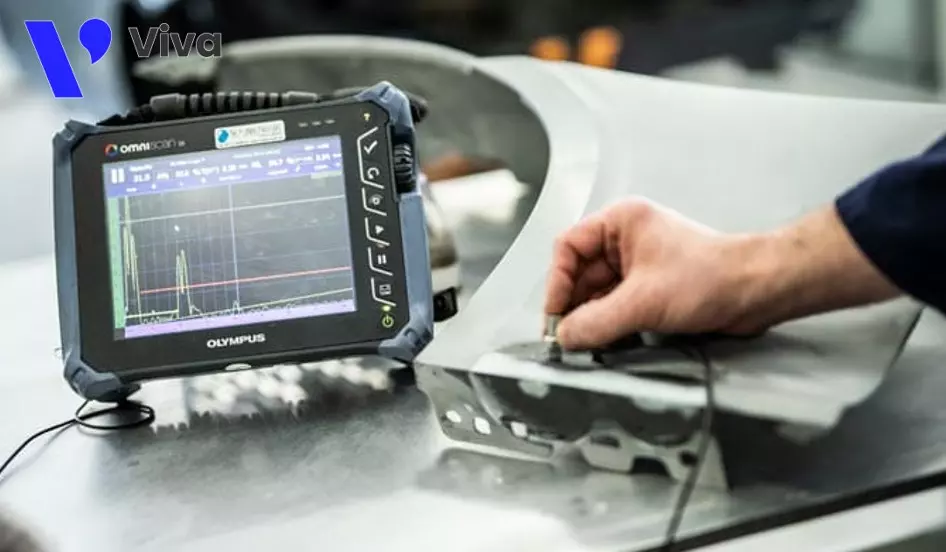Ultrasound Waves
All of us who have ever spent time “sitting on school desks” have surely heard about, or even repeatedly heard about, ultrasound waves, a type of mechanical wave with a high frequency, and above all, they are applied in many different fields. In today’s article, we will together learn about this type of wave.
Understanding Ultrasound Waves
Concept
Ultrasound waves are defined as a type of mechanical wave with a frequency greater than 20 kHz and can reach up to several GHz. In essence, ultrasound and basic sound waves are similar, but due to ultrasound waves having frequencies beyond the audible range of the human ear, we cannot hear them.

Properties
Properties of ultrasound waves:
- Wave propagation: Ultrasound waves have the ability to propagate through various types of materials in all three states: solid, liquid, and gas. They are only impeded in a vacuum environment.
- Wave propagation velocity: In the same medium, ultrasound waves propagate at the speed of sound. Furthermore, for different material mediums, the propagation velocity of ultrasound waves will vary.
- Wavelength: Due to higher frequencies, ultrasound waves have shorter wavelengths.
- Reflection: During wave propagation, if there is a change in the material medium, a portion of the ultrasound wave will be reflected back.
- Biological effects: Ultrasound waves have certain effects on living organisms, and the degree of influence on organisms varies depending on the species and the frequency threshold of the waves.
How Are Ultrasound Waves Generated?
Before the discovery of the existence of ultrasound waves, this type of wave had already existed naturally and was produced by creatures such as bats and dolphins. These animals generate ultrasound waves to locate prey during the hunting process.
After the discovery of ultrasound waves and the recognition of their special properties, many researchers have applied this type of wave to various types of devices to perform specific tasks.
The deliberate generation of ultrasound waves depends on the type of emitting device. The common technology applied to generate ultrasound waves is to provide an appropriate current to a piezoelectric crystal. Under the influence of this crystal’s current, it vibrates, thereby converting electrical pulses into high-frequency mechanical oscillations.

Does ultrasound waves harm humans?
Ultrasound waves at low intensity and frequency, used in medicine and common industrial applications, are considered safe for humans and do not pose health risks.
However, at higher intensity levels, ultrasound waves can cause adverse effects. For example, in animal experiments, high-intensity ultrasound waves can lead to effects such as diarrhea, abdominal pain, physical weakness, and even death. Therefore, when using ultrasound waves at higher intensity levels, it is necessary to ensure safety measures and control the concentration of ultrasound waves to avoid any impact on human and animal health.
In summary, when used correctly and within safe limits, ultrasound waves are a very useful technology and do not harm humans. However, it is still advisable to limit exposure to ultrasound waves at all frequency levels.
Some applications of ultrasound waves
With their unique properties and rapid technological advancements, ultrasound waves are applied in various fields including military, medical, industrial measurement, mechanical engineering, and more. Let’s explore specific applications in different fields.
Medical applications
In the medical field, the most notable application of ultrasound waves is in ultrasound machines. These devices emit sound waves into the human body, and when the sound waves encounter internal organs, they are reflected back. Combined with other components of the machine, we obtain images that represent the condition of organs within the body.

Measurement applications
Ultrasound waves are utilized in non-invasive measurement devices. Some examples include devices that measure the thickness of materials through ultrasound waves, devices that measure flow velocity often referred to as ultrasonic flow meters, and more.

Applications in mechanical engineering
In mechanical engineering, especially in projects involving machinery and equipment with high technical requirements, certain manufacturing and processing methods such as welding and casting can have hidden flaws deep inside. These flaws are very dangerous as they can compromise the structure or even pose risks to future operators. To address this issue, ultrasound testing machines are used to inspect the manufacturing quality of products.

General Conclusion
Ultrasonic waves are a type of mechanical wave with a frequency higher than that of sound waves.
They are widely applied in medicine, industry, and science. Ultrasonic waves are used for disease diagnosis, treatment, material analysis, localization and distance measurement, product quality testing, and many other applications.
However, they can also be harmful to humans if not used correctly. In general, ultrasonic waves bring many benefits to humans and are considered an important and indispensable technology in medicine, industry, and science.
